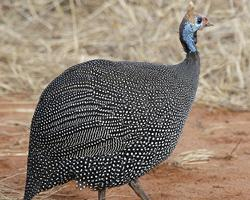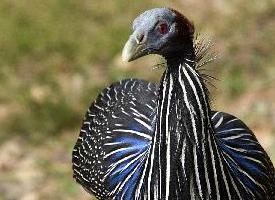
Známé také jako
- Perlička obecná
- Perlička štětcovitá
Váhy a míry
| Délka | od 53 do 63 cm |
|---|---|
| Hmotnost | 1,3 kg |
Stav ohrožení
| Neohrožen |
Popis zvířete
The Helmeted Guineafowl (Numida meleagris) is a fascinating and distinctive bird species that is native to Africa but has been introduced to various parts of the world, such as the West Indies, Brazil, Australia, and southern France. This bird is well-known for its unique appearance, social behavior, and ecological significance. It belongs to the family Numididae, which comprises several species of guineafowl.Appearance
The Helmeted Guineafowl is a medium-sized bird, typically weighing between 1.3 to 1.6 kilograms (2.9 to 3.5 pounds) and reaching a length of 53 to 58 centimeters (21 to 23 inches). Its most striking feature is its head, which is adorned with a bony helmet or casque, and its face is decorated with red and blue skin patches. The bird's plumage is predominantly gray-black, speckled with white spots, which provides excellent camouflage in its natural habitat. The bird's wings are short but strong, enabling it to make swift, powerful flights over short distances. Its strong legs and feet are adapted for scratching the ground in search of food.
Behavior and Ecology
Helmeted Guineafowls are highly social creatures, often found in flocks ranging from a dozen to several hundred birds outside the breeding season. They communicate with each other through a variety of sounds, including a characteristic "kek-kek-kek" call. These birds are ground-dwelling and spend most of their time foraging for food. Their diet is omnivorous, consisting of seeds, fruits, greens, and invertebrates such as insects, worms, and snails. They play a crucial role in controlling insect populations and dispersing seeds in their habitats.
During the breeding season, which varies depending on their geographical location, Helmeted Guineafowls become more territorial. The female lays a clutch of 6 to 12 eggs in a well-hidden nest on the ground. The eggs are incubated for about 26 to 28 days, primarily by the female, while the male stands guard nearby. The chicks are precocial, meaning they are relatively mature and mobile from the moment of hatching.
Habitat and Distribution
Originally from Africa, Helmeted Guineafowls inhabit a wide range of environments, from arid savannas to open woodlands and farmlands. They are adaptable birds that can thrive in various habitats, as long as there is adequate cover for nesting and roosting. Their adaptability has facilitated their introduction to other parts of the world, where they are often kept as farmyard birds due to their ability to control pests and their distinctive, flavorful meat.
Conservation Status
The Helmeted Guineafowl is classified as Least Concern by the International Union for Conservation of Nature (IUCN), reflecting its wide distribution and stable population size. However, in some regions, their populations are affected by habitat destruction, hunting, and predation. Conservation efforts in these areas focus on habitat preservation and sustainable hunting practices to ensure the long-term survival of these unique birds.
In summary, the Helmeted Guineafowl is a remarkable bird with a distinctive appearance, interesting social behavior, and significant ecological role. Its adaptability has allowed it to thrive in a variety of environments, both in its native Africa and in introduced habitats around the world.
Podobná zvířata
Nové fotografie zvířat
Top 10 zvířat
- Chinese water dragon (Physignathus cocincinus)
- Galápagos tortoise (Geochelone nigra complex)
- Dolphin gull (Leucophaeus scoresbii)
- Japanese macaque (Macaca fuscata)
- Colombian red howler (Alouatta seniculus)
- Sea urchins (Echinoidea)
- Moustached guenon (Cercopithecus cephus)
- Diana monkey (Cercopithecus diana)
- Common reed warbler (Acrocephalus scirpaceus)
- Common house mosquito (Culex pipiens)
